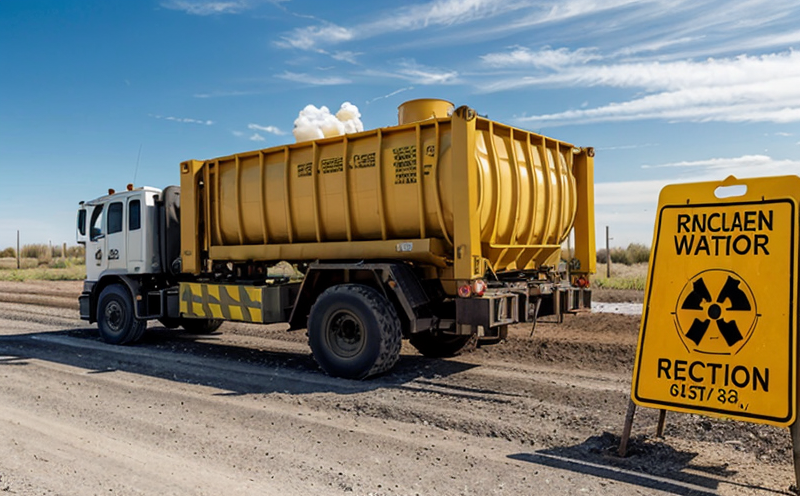ISO 18589 Measurement of Radioactivity in Nuclear Waste Samples
The ISO 18589 standard provides a robust framework for measuring radioactivity in nuclear waste samples, ensuring compliance with international safety and regulatory standards. This test is crucial for the accurate quantification of radionuclides within radioactive waste, enabling safe handling, transport, treatment, and disposal processes.
The process begins with proper sample preparation. Samples must be collected from various points of interest in a nuclear facility or site where radioactive waste accumulates. The samples are then transported to the laboratory under controlled conditions to minimize contamination risks. Once received at the lab, the samples undergo rigorous quality checks before proceeding to analysis.
The analytical methods prescribed by ISO 18589 include gamma spectrometry, alpha spectroscopy, and beta/gamma coincidence counting. These techniques allow for precise detection of various radionuclides present in the waste material. The choice of method depends on the type and concentration of radioactive isotopes expected in the sample.
Quality assurance is paramount throughout this process. Rigorous calibration of instruments ensures accurate measurements, while regular audits verify adherence to standard procedures. Cross-checks using multiple methods provide additional confidence in the results. This comprehensive approach guarantees that the test outcomes are reliable and reproducible.
The final step involves generating a detailed report summarizing all findings. The report includes specific details such as the type of waste, the identified radionuclides, their concentrations, and any relevant regulatory compliance information. Compliance with ISO 18589 ensures that these reports meet international standards, providing transparency and trustworthiness in nuclear waste management.
The importance of accurate radioactivity measurement cannot be overstated in the field of nuclear waste management. This test not only aids in safeguarding public health but also helps prevent environmental contamination by ensuring safe disposal practices. By adhering to ISO 18589, laboratories demonstrate their commitment to maintaining the highest level of safety and precision.
In conclusion, ISO 18589 is an indispensable tool for nuclear waste management, offering a standardized approach to measuring radioactivity in waste samples. Its implementation ensures that all stakeholders involved—whether at the site of generation or disposal—are working towards shared goals of safety and regulatory compliance.
Scope and Methodology
The scope of ISO 18589 covers the measurement of radioactivity in solid, liquid, and gaseous radioactive waste. It outlines procedures for sample preparation, analysis using gamma spectrometry and alpha/beta/gamma coincidence counting, and reporting results. The methodology ensures that all relevant radionuclides are detected and quantified accurately.
Sample preparation involves several critical steps:
- Cleaning and labeling of containers
- Sieving or grinding to ensure homogeneity
- Mixing samples thoroughly before extraction
- Filtering for liquid samples
- Drying and weighing solid samples
The analysis itself is performed using specialized equipment:
- Gamma spectrometry for detecting gamma-emitting radionuclides
- Alpha spectroscopy for alpha-emitting materials
- Beta/gamma coincidence counting to differentiate between beta and gamma emissions
The results are analyzed according to the standard's guidelines, ensuring that all detected radionuclides fall within acceptable limits. This comprehensive approach guarantees accurate and reliable measurement of radioactivity in nuclear waste samples.
Why Choose This Test
- Compliance with International Standards: Adherence to ISO 18589 ensures that your radioactive waste management practices meet the highest international standards.
- Precision and Reliability: The standardized procedures provide consistent, accurate results every time.
- Safety Assurance: Accurate measurement of radioactivity helps prevent potential health risks and environmental contamination.
- Regulatory Compliance: Ensures that all operations comply with relevant national and international regulations.
The ISO 18589 test is essential for quality managers, compliance officers, R&D engineers, and procurement teams involved in nuclear waste management. By choosing this test, you ensure that your processes are safe, efficient, and compliant with the latest industry standards.
Quality and Reliability Assurance
The ISO 18589 measurement of radioactivity involves several quality assurance measures to ensure reliability and accuracy:
- Instrument Calibration: Regular calibration ensures that all instruments operate within specified tolerances.
- Audits and Cross-Checks: Periodic audits and cross-checks using multiple methods provide additional validation of results.
The laboratory maintains a strict quality management system that includes:
- Standard operating procedures (SOPs)
- Training for all personnel involved in the testing process
- Continuous monitoring and improvement of processes
This systematic approach guarantees that the results are accurate, reliable, and consistent. By adhering to these stringent measures, we ensure that every test conducted meets or exceeds ISO 18589 requirements.





